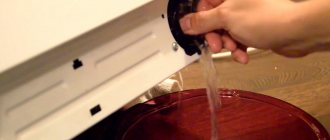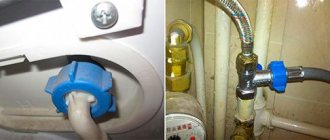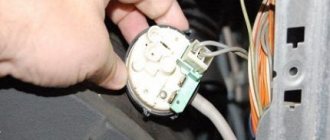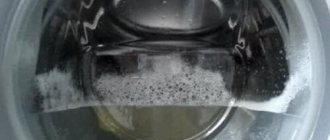Modern household appliances are not immune to various types of breakdowns, which cause their users a lot of anxiety. For example, if you notice that your washing machine is constantly filling with water during the wash cycle, you will probably realize that something is wrong with it and want to take steps to solve the problem. Indeed, delaying repairs in this situation is a big waste, considering how much water will be wasted, as well as the prices for water utility services. The first thing that immediately comes to mind for most people is to contact a home appliance repair specialist. But this solution is not always the best, since sometimes you can fix everything on your own. This will depend on the nature of the problem encountered.
“Symptoms” of a breakdown
As a standard, during the washing process, the automatic machine fills and drains water several times (usually 2-3). It is difficult not to notice that liquid enters the system continuously. The main “symptoms” noted by users in this situation:
- the incessant noise of water being collected;
- extended washing program. Since the process is not carried out correctly, the cycle time increases;
- At the end of washing, the clothes are still dirty, with soap smudges. This is observed because the required concentration of the soap solution is not achieved.
It is worth eliminating the reason for the machine’s constant intake of water immediately after identifying the problem.
It is dangerous to operate the washing machine with such a violation. This can lead to complete equipment failure.
What could have gone wrong?
Various factors can cause the Indesit machine to constantly fill with water. Initially, you should identify all possible problems, and during the diagnostic process, narrow down the range of breakdowns. So, what can cause a continuous supply of liquid from the water supply:
- incorrect connection of the washing machine;
- damaged washing machine tank;
- broken pressure switch;
- broken intake solenoid valve;
- faulty control module.
If only the purchased machine showed a problem in the first wash, it is not necessary that it was connected incorrectly. Perhaps there is a normal manufacturing defect. In this case, it is better not to carry out repairs yourself, but to submit the equipment for warranty service to a service center.
Let's check the drain hose
Diagnostics of the Indesit washing machine should be carried out from simple to complex. First of all, it is recommended to check the connection of the machine. Most often, Indesit washing machines keep drawing water due to an incorrectly connected drain hose.
The equipment always comes with instructions that describe in detail the process of connecting the machine to house utilities. The main rule is that the drain hose must be positioned at a height of 50-60 cm from the floor. If you extend the hose lower, the water will be removed by gravity into the pipe, the pressure switch will send a signal about the empty tank to the “brain”, and the control center will give the command to fill the system with water again. And so on in a circle.
You can check if this is the reason visually - just inspect the sleeve and make sure that it is at a sufficient height. If inspection is not possible, it is possible to evaluate the position of the hose in another way:
- turn on any washing program;
- wait until the tank is full;
- start the “Drain” mode;
- In the middle of the descent, press the "Pause" button.
If the liquid continues to leave the system even when the process is paused, then the problem is definitely in the drain hose. If the water level remains the same, you will have to look for the problem further.
By the way, often the equipment comes with a special loop designed to secure the drain hose. The hose is inserted into the plastic element, thus securing it in the correct position.
Why does the washing machine fill with water and immediately drain it?
If the collected liquid immediately goes down the drain, the system reacts to the lack of water in the tank and begins to supply it again and again. So the process continues ad infinitum until the cause of what is happening is eliminated.
Sewer blockage
If the general sewer system is clogged, when neighbors drain waste, the riser fills and a decrease in pressure is observed in the pipes. At this moment, liquid from the tank begins to be forced out into the sewer, and its lack in the tank is compensated by constant topping up. The easiest way out of an unpleasant situation is to disconnect the drain hose from the sewer pipe and lower it into a bathtub or other large reservoir. In the future, in order to comfortably use the device, you should clean the sewer system.
The first solution is to lower the drain hose into the bathroom
Intake valve malfunction
If the membrane of a part is weakened, water will constantly flow out of the tank with weak pressure. If it completely fails, the valve will not close at all, then the liquid will flow out intensively. The situation will be similar to the incorrect connection of the drain hose.
Washer inlet valve
Healthy! Determining that the valve is faulty is very simple. If water constantly flows into the tank, even when the device is unplugged, then there is a problem with it.
There is no point in repairing the part; due to its design features, it has a limited shelf life. The best option would be to replace the valve with an identical new one.
Pressostat malfunction
As in the case described above, if a component fails, the signal indicating that the tank is full does not arrive at the control unit, which is why the error occurs. Failure can be associated with either damage to the sensor or its clogging. The part should be removed from the housing and inspected for debris and cracks. If in the first case it is enough to clean the pressure switch from dirt, then in the second case it is better to replace it immediately.
New pressure switch
Washing machine tank leaking
If there is a puddle under the washer, the cause of the malfunction may be damage to the integrity of the tank or a loose gasket between the two halves of the component. Often a problem arises if you do not check the pockets before washing - then metal objects can easily damage the body. You can try to seal the defect with a good sealant, but the effect does not last long. The only way out is to replace the tank with a new one, for which you should seek the help of a specialist.
You can use a sealant, but it is better to replace the tank with a new one
Incorrect connection of the washing machine
The main problem that can occur when connecting the unit yourself, as a result of which water constantly flows in and out, is the incorrect location of the drain hose. It is very easy to visually determine the problem - the hose should not lie on the floor, but should be located at a height of 50-60 cm relative to the bottom of the body.
Correct and incorrect connection diagram
Advice! You can correct the situation by using a special anti-siphon attachment or a plastic loop. Any of these details serves to prevent trouble.
Electronic module failure
If the control unit is faulty, the necessary components do not receive the necessary command in a timely manner - to fill up or drain water. A malfunction occurs, which can only be eliminated by replacing the module with a new one. Electronics is a complex system that must be handled by a specialist. If all the above steps do not produce results, then you need to call a technician to check the functionality of the control element.
Only a specialist should work on electronics
Important! Regardless of whether the equipment is functioning properly or malfunctions have occurred, the electrical module should be replaced every three years, as it has a limited shelf life.
Problems with the fill valve
In some cases, the continuous intake of water is explained by a failed inlet valve. When the sensor is faulty, fluid enters the system constantly. So, when the wash starts, the “brain” gives a command to fill the tank. A broken valve cannot stop drawing water. The protective system is activated, and if there is an excess of liquid, it begins to drain it. The process happens in a circle. What should the housewife do in this case?
Please note:
- on the tank filling speed. If the water comes in slowly, the valve membrane is probably damaged;
- Filling too quickly indicates a breakdown of the electromagnetic element itself.
The intake valve cannot be repaired; you will have to buy and install a new part.
The sequence of actions when dismantling and subsequent installation of the element will be as follows:
- turn off the power to washing equipment;
- remove the top cover from front-loading machines, or the side cover from machines with a vertical loading type;
- find the fill valve, disconnect all wiring and pipes from it;
- unscrew the bolts holding the valve or loosen the fixing latches (depending on the type of fastening of the element on your washing machine model);
- remove do;
- put the new valve in place, tighten the bolts (or secure it with latches), connect the pipes and wires;
- assemble the washing machine body;
- run a test wash.
Changing the valve is not difficult; this work can be done at home. The main thing is to select a replacement part that is similar to the one being dismantled.
How to find and eliminate the cause of the breakdown?
The easiest way to detect the cause of the problem of constant water supply is visually. It is enough to check that the drain hose is higher than the machine drum. If this is not the case, then simply lift and secure it at a height of 50 cm from the floor or higher.
Sometimes it can be difficult to see where the water drain hose is located. In this case, you can determine the problem as follows: turn on any washing program, wait for the tank to fill with water. After this, select the water drain mode. About halfway through the draining process, you need to pause and listen. If you hear that water continues to flow out, then the drain hose is located low and its position needs to be adjusted. If the cause of the malfunction is the location of the drain hose, then such repairs can be done at home.
If the water level sensor is faulty, you need to look for the cause inside the washing machine. When starting to troubleshoot, disconnect the washing machine from the power supply.
A malfunction of the pressure switch or the tube leading to it is one of the common problems with washing machines. You will need to remove the back cover of the car, there is a sensor on the upper left side.
It is a cylinder with a rubber membrane. Do not rush to disconnect it from the contacts. First check to see if oxidation has occurred; sometimes it is enough to clean the contacts and the sensor will return to normal. Inspect the pressure switch tube. If there are cracks in it, seal them. If the tube is clogged inside, disconnect it and clear it thoroughly. Check the rubber membrane, it should be intact. If the contacts and tube are in order, then the part requires replacement.
The sensor itself is marked with the manufacturer's name. When purchasing a spare part, you should refer to the labels on the sensor.
The procedure for replacing the pressure switch: disconnect the tube, compression chamber, terminals and unscrew the bolts. We remove the faulty part and install the new one in the reverse order.
If the washing machine fills with water even when it is turned off, then the problem is in the inlet valve. The problem with this part can be of 2 types: low water pressure due to the membrane on the valve, or water quickly collects due to a damaged valve.
To get to the valve, you will have to remove the lid of the washing machine. In models with vertical loading - a side cover. The valve will be located at the bottom. In front-loading models there is a top cover, the valve is directly under it. We take out the valve, having first disconnected the wires and fasteners from it. A new intake valve is installed in the reverse order, and we begin to check the operation of the machine. Be sure to run any wash program.
Unfortunately, if after checking the drain pipe, water level sensor and inlet valve the problem is not found, then there is a high probability of a problem - the control unit of the washing machine is broken. You won't be able to cope here on your own. The unit can only be properly replaced by a service center specialist. This part cannot be repaired.
In some models of household appliances, when water is constantly added, an error may appear on the display.
The level sensor is acting up
The pressure switch controls the volume of water in the system. When the tank is filled to the required level, the sensor transmits a signal to the control module, and the “brain” sends a command to stop collecting liquid. If the pressure switch fails, the control unit does not receive correct information about the amount of liquid in the tank. As a result, the normal washing cycle is disrupted. The level sensor stops functioning correctly for various reasons:
- oxidation of its connectors and contacts;
- short circuit of the pressure switch wiring;
- loss of membrane tightness;
- clogged or defective pressure pipe.
To begin with, you can try to repair the sensor - clean oxidized contacts, weld defects, clear blockages. If this does not give results, you will have to buy and install a working pressure switch. The algorithm of actions will be as follows:
- remove the “top” of the machine body by unscrewing the bolts holding the cover;
- disconnect the pressure tube from the level sensor;
- disconnect the chip with the wiring;
- remove the pressure switch by releasing the latch that secures it;
- install a working element;
- make the connection in the reverse order (chip, tube);
- Secure the top cover of the washer in place.
When repairing an automatic machine, be sure to follow the safety rules - disconnect the equipment from the network and close the shut-off valve.
In such a situation, it is also very important to select a part similar to the one removed. Find out the exact name of the “home assistant” model and then purchase a replacement part.
Why is there no water in the drum?
The first reason that water does not flow into the CM drum is a clogged inlet valve. It accumulates small debris from the water supply system, which is retained by a special mesh filter.
The filter is installed on the outside of the SMA housing, just before the inlet valve. To get to it, you need to unscrew the inlet hose.
After removing the mesh, rinse it under the tap and clean it with an old toothbrush, then put it back in place. It also wouldn’t hurt to rinse the hose to remove any possible blockages, and at the same time inspect it for kinks and cracks.
If checking and cleaning the filter did not bring the expected results, and a test wash showed that water still does not enter the drum, we may be talking about a more serious failure.
Damage to the main tank
A crack in the tank of an Indesit washing machine is far from uncommon. Finding out about a hole is easy - water will accumulate under the washer during washing. This breakdown is very dangerous, as it can cause a flood in the apartment, causing damage not only to your home, but also to your neighbor’s.
The most dangerous cracks appear at the bottom of the tank. Holes in the upper part are not so bad, because in this case the water will not flow onto the floor - most Indesit programs provide for only half filling the drum with water. To inspect the bottom of the tank:
- Turn off the power to the washing machine, disconnect the inlet and drain hoses from the communication terminals;
- drain the water from the tank (through a garbage filter or drain hose);
- move the machine to the middle of the room (the ideal place for repairs would be the garage);
- place the washing machine on its right side;
- inspect the bottom of the tank. You can use a marker to mark suspicious places that look like holes.
It is ideal to replace a leaking SMA tank with a new one. However, if the defect is not too large, you can try to restore the integrity of the element with a high-temperature, waterproof sealant or cold welding. You can take the equipment to a workshop and ask a specialist to solder the tank. However, you should understand that it will be difficult to obtain a warranty for such repairs.
Water appears when the unit is operating
If the water in the drum of the machine does not drain completely or does not drain at all, the problem lies in the breakdown of parts of the SMA drain system.
The drain filter is clogged
Situation: . To fix the problem, you first need to check the drain and its filter.
, which is located near the floor under a closed lid. The most common cause of such stagnation of water is clogging. Follow the instructions:
- Manually drain the water from the hose - otherwise there is a risk of spilling all the water onto the floor.
- Unscrew the filter and rinse with running water.
- Examine the pump, which is located behind the filter: you need to turn on the “drain” mode and see if the pump blades are spinning.
- If the pump is also clogged with dirt and the movement of the blades is difficult, clean it.
- Reinstall the filter and restart the drain program. If everything worked, then the reason was that the drain was dirty.
Broken pump
If no dirt is found when disassembling the filter and inspecting the pump, the breakdown may be more serious. If the washing machine still tries to get rid of the liquid, and at the same time makes unnecessary noise, then it’s probably time to overhaul the pump. How to check if the pump is working? If the drain pump blades (impeller) do not move during the drain mode, this clearly indicates its malfunction.
It is impossible to repair the pump yourself; you must call a specialist. In 90% of cases, the problem is solved by replacing the broken part with a new one. You can buy a new pump either independently or rely on the service center specialists. They will tell you where to buy a pump that is suitable for your SMA model.
Looking at electronics
If all the previously listed reasons for the continuous supply of water into the tank are excluded, you will have to check the control module of the Indesit washing machine. The electronic unit controls the entire process, receives signals from various sensors during washing and transmits further instructions on the operation of the machine. If the control board fails, the washing machine will not be able to function properly, and the operation of the machine components will be disrupted. The main reasons why the control module is damaged:
- voltage drops in the network;
- exposure to moisture on the board;
- mechanical defect;
- natural wear and tear of the block.
If the problem lies in the “brain of the washing machine,” then it is better not to start repairs at home. Working with electronics requires certain knowledge and experience. In order not to aggravate the situation, it is recommended to seek help from a specialist.
The sooner after identifying a problem you begin to eliminate the cause, the fewer “sacrifices” you will be able to make. Postponing repairs will lead to much more serious damage to the SMA.
Interesting:
- Kandy's washing machine constantly fills with water
- The washing machine constantly fills and drains water
- LG washing machine constantly fills with water
- The Ardo washing machine fills and immediately drains water
- Why doesn't the Indesit washing machine fill with water?
- Whirlpool washing machine does not fill with water
Reader comments
- Share your opinion - leave a comment
Water appears in a non-working machine
Situation: the machine is not in use, but the water in the tank unit is rising. The first step is to block it technically. If the problem is not solved, then the issue is the false functioning of the water drain
. Often wastewater penetrates into the unit due to incorrect, namely, inaccurate placement of the hose along the drain. This means that you need to carefully check the connection of the unit again.
If all connections are made properly, then the source of the problem is most likely a clog accumulated in the pipe. What flows from the sewer will accumulate inside the device, find no way out and rise up the hose. What to do? Eliminate this kind of blockage.
If the water does not disappear, then apparently the car will have to be disassembled. Possible malfunction of the inlet shut-off valve
. Why does this happen?
- If the water is of low quality, then it is possible that there may be gravel and small pebbles in it. As a result, the valve becomes clogged and malfunctions.
- Valve wear is also possible. The problem can be solved only by replacing it.
In addition, there may be a wiring fault, which ultimately affects the valve through current. For diagnostics of this kind, it is better to contact professionals: they will identify the broken electronics part and repair it.











